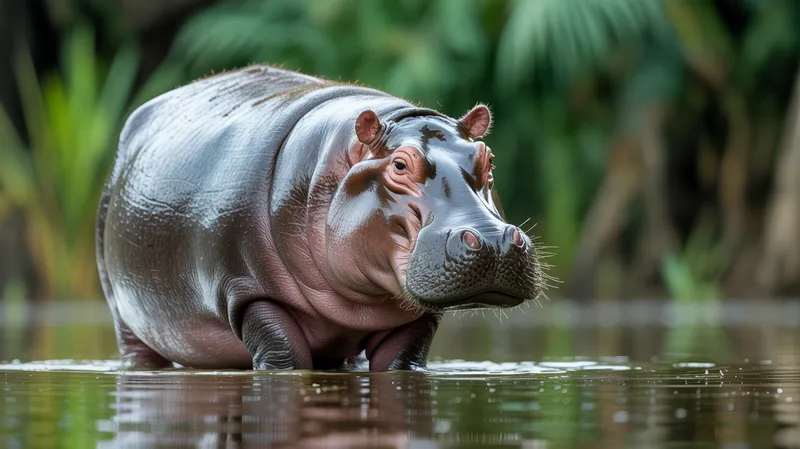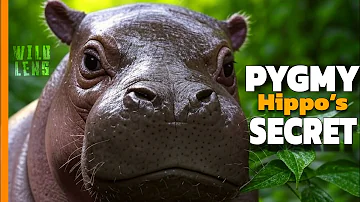
Pygmy Hippo
Hexaprotodon liberiensis

Meet the Pygmy Hippo
The pygmy hippo is a small, elusive relative of the common hippopotamus, native to the forests and swamps of West Africa. It is semi-aquatic, spending much of its time in water to keep its sensitive skin moist and regulate its body temperature. Unlike its larger cousin, the pygmy hippo is more solitary, shy, and primarily nocturnal, foraging for food at night. Its compact size and secretive lifestyle make sightings in the wild rare and contribute to its vulnerable conservation status.
Classification
Mammal
Habitat
Swampy forests and wetlands
Diet
Herbivore
Lifespan
30–35 years (in captivity), 20–25 years (in the wild)
Conservation
Endangered
Weight
180–275 kg
📖Fascinating Facts
Forest Dweller
Pygmy hippos inhabit dense, swampy forests of West Africa, unlike the common hippo which prefers open rivers and lakes.
Nostrils Adapted for Water
Their nostrils and ears can close to keep water out while submerged, an adaptation for their semi-aquatic lifestyle.
Solitary Lifestyle
Pygmy hippos are mostly solitary and nocturnal, foraging alone at night and rarely seen in groups except for mothers with young.
📋Detailed Description
The pygmy hippopotamus (Choeropsis liberiensis), sometimes classified as Hexaprotodon liberiensis, is a small, semi-aquatic mammal endemic to the dense forests and swamps of West Africa, with the largest populations in Liberia and smaller, fragmented groups in Sierra Leone, Guinea, and Ivory Coast. Adults typically measure 150–175 cm in length, stand 75–100 cm at the shoulder, and weigh between 180–275 kg, making them about a quarter the size of the common hippopotamus. Their skin is smooth, hairless, and dark greenish-black, secreting a natural oily substance known as 'blood sweat' that acts as a sunscreen and antimicrobial agent. The pygmy hippo has a barrel-shaped body, short legs, and a proportionally smaller head with eyes set more to the sides, adaptations for moving through dense undergrowth. Unlike the gregarious common hippo, pygmy hippos are solitary or found in pairs, displaying elusive and secretive behavior. They are primarily nocturnal, emerging at dusk to forage on ferns, broad-leaved plants, fruits, and roots, while spending daylight hours resting in swamps or riverbanks to avoid dehydration. Their toes are less webbed than those of the common hippo, aiding terrestrial locomotion. Pygmy hippos are excellent swimmers and can close their nostrils and ears underwater. Lifespan in the wild is estimated at 30–35 years, though data are limited due to their cryptic nature.
💡 Did you know?
The pygmy hippo was not scientifically described until the 19th century due to its secretive, nocturnal habits and dense forest habitat.
🔬Research & Sources
Wikipedia Summary
The pygmy hippopotamus or pygmy hippo is a small hippopotamid which is native to the forests and swamps of West Africa, primarily in Liberia, with small populations in Sierra Leone, Guinea, and Ivory Coast. It has been extirpated from Nigeria.
Last Modified: 6/4/2025
🎭Behavior & Social Structure
Pygmy hippos are predominantly solitary, with individuals maintaining overlapping home ranges of 1–2 km², marked by dung and secretions. They are crepuscular to nocturnal, foraging mainly at night and resting during the day in dense vegetation or submerged in water to avoid heat and predators. Feeding involves browsing on a variety of forest plants, fallen fruits, grasses, and aquatic vegetation, with a preference for soft, succulent foliage. Unlike the aggressive territoriality of common hippos, pygmy hippos exhibit minimal social interaction outside of mating and maternal care. They communicate through low grunts, wheezes, and scent marking. Their daily routine consists of alternating periods of foraging and wallowing, with frequent use of established trails between feeding and resting sites. They are generally shy and will retreat quickly into water or thick cover if disturbed.
👶Reproduction & Life Cycle
Pygmy hippos are believed to be polygynous, with breeding occurring year-round but peaking during the rainy season (May–October). Courtship and mating take place in water or on land. After a gestation period of approximately 180–210 days (6–7 months), females give birth to a single calf, rarely twins. Calves weigh 4.5–6.4 kg at birth and are precocial, able to stand and walk within hours. Mothers are highly protective, nursing their young in secluded, dense cover or shallow water for the first few weeks. Calves are weaned at 6–8 months but may remain with the mother for up to a year. Sexual maturity is reached at 3–5 years. Parental care is exclusively maternal, with males playing no role in rearing offspring.
🛡️Adaptations & Survival
Pygmy hippos possess several adaptations for their semi-aquatic, forest-dwelling lifestyle. Their dense, smooth skin secretes a pinkish fluid with antimicrobial and sunscreen properties, protecting against infection and UV radiation. The streamlined body and reduced webbing on the feet facilitate movement through both water and dense undergrowth. Nostrils and ears can close to prevent water entry during submersion. Their eyes are positioned laterally rather than dorsally, aiding navigation in thick vegetation rather than open water. Behavioral adaptations include nocturnality to avoid heat stress and predation, and the use of established trails for efficient movement between resources. Their digestive system is adapted for a high-fiber, herbivorous diet.
📚Research Sources
🎨Cultural Significance
The pygmy hippo holds a subtle place in local folklore, often regarded as a symbol of mystery and forest spirits due to its secretive habits. In some West African cultures, it is associated with water spirits and is believed to possess magical properties, although it is less prominent in mythology than the common hippo. There are occasional reports of traditional medicinal uses, but these are rare. The species has gained international attention as a flagship for rainforest conservation and is featured in educational and ecotourism initiatives.
🔬Recent Research & Discoveries
Recent research has focused on the genetics and taxonomy of the pygmy hippo, confirming its distinct lineage from the common hippo and supporting its placement in the genus Choeropsis. Camera trap studies and environmental DNA (eDNA) surveys are improving understanding of distribution and population size. Studies on captive populations have provided insights into reproductive biology, health, and longevity, informing ex-situ conservation. There is ongoing research into the species' role in seed dispersal and forest ecology. Conservation genetics is a growing field, aiming to assess genetic diversity and inform management of fragmented populations.
🎥Wildlife Videos

Close up with the Hippos - Spectacular Footage of the African Landscape | Full Documentary
This nature documentary focuses on the lives of hippopotamuses from an entirely new perspective. Hippos lead a semi aquatic ...
Free High-Quality Documentaries

Adorable Baby Pygmy Hippo Takes Her First Swim | Nature's Newborns | Real Wild
Veterinarian Steve Leonard watches an adorable pygmy hippo born in the UK take her tentative first swim with mom, encounters ...
Real Wild

Mother Hippo Fights to Protect Her Calf | Natural World | BBC Earth
Chaos erupts when a new mother introducers her calf into the hippopotamus pod... Subscribe: http://bit.ly/BBCEarthSub ...
BBC Earth

Pygmy Hippo Secret | Wild Lens #wildlife
Pygmy Hippo Secret | Wild Lens । Pygmy Hippo documentary national geographic। Pygmy Hippo documentary in hindi।
Wild Lens

The Madagascar Pygmy Hippo Lost Island Hippo
Discover the enchanting world of the Madagascar Pygmy Hippo, a unique and captivating creature that is one of nature's ...
Paws and Claws

The Mini-Hippo: The Pygmy Hippopotamus
This documentary delves into the fascinating world of the pygmy hippopotamus, a smaller relative of the common hippopotamus.
Ases World
🌍Habitat Information
The Pygmy Hippo typically inhabits Swampy forests and wetlands environments. Pygmy Hippos have adapted to their environments with specialized features and behaviors.
Primary Habitat:
Swampy forests and wetlands
More detailed habitat information will be available soon.
🛡️Conservation Status
The Pygmy Hippo is currently classified as Endangered. Conservation efforts are crucial for preserving this species for future generations.
Common Threats:
- 🏠Habitat loss and fragmentation
- 🌡️Climate change impacts
- 🎯Hunting and poaching
- 🏭Human-wildlife conflict
⚠️Threats & Conservation Challenges
The pygmy hippo faces numerous threats, primarily habitat loss due to logging, agricultural expansion, and human settlement. Fragmentation of forest habitats isolates populations, reducing genetic diversity and increasing vulnerability. Hunting for bushmeat and accidental capture in snares further threaten survival. Natural predators include leopards and crocodiles, but human impact is the predominant challenge. The global population is estimated at fewer than 2,500 mature individuals and is declining. Conservation is hindered by the species' elusive nature, making population monitoring difficult. Protected areas exist, but enforcement is inconsistent, and habitat outside reserves continues to shrink.
🔬Scientific Classification
Scientific Name
Choeropsis liberiensis
Classification Hierarchy
🔍 About Taxonomic Classification
Taxonomic classification is a hierarchical system used by scientists to classify and organize living organisms based on shared characteristics and evolutionary relationships.
The system moves from broad categories (Kingdom) to increasingly specific ones, with each animal's scientific name typically consisting of its Genus and species.
📝Community Notes
Share your observations and insights about the Pygmy Hippo with our community of wildlife enthusiasts.
Join Our Community
Sign in to share your observations and connect with fellow wildlife enthusiasts.
Sign In to ContributeNo community notes yet
Be the first to share your observations about the Pygmy Hippo!
Explore Pygmy Hippo
Select a tab above to learn more about this amazing animal.
📸Photo Gallery
No photos available for this animal yet.
🌟Discover More Wildlife
Continue your journey of discovery with more fascinating animals from our database
